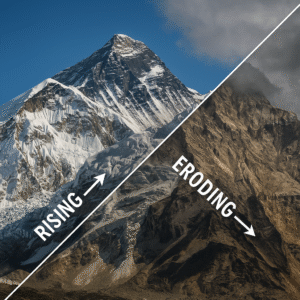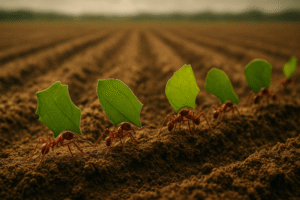Fun fact: in the past 30 years, trees in the Amazon rainforest have increased their average basal area (cross-section at chest height) by about 3.3 % per decade.
That’s right—Amazon Rainforest Trees Getting Bigger: What a New Study Says is not just a catchy headline, it’s a reality born from decades of scientific observation.
It feels a bit strange to say “good news” about the Amazon these days, given all the talk of deforestation, fires, and climate collapse. But this new study gives us a sliver of hope—and also a puzzle. Bigger trees? In a climate crisis? It sounds like a headline made for clickbait, but the deeper story is far more complex (and more urgent).
The Study That Shook the Forest
A global team of nearly 100 scientists from more than 60 institutions examined 188 mature forest plots across the Amazon over three decades. Their results are clear: the mean basal area of trees has grown by about 3.3 % every decade.
What’s fascinating is that the increase is not just among the tiny scrub or mid-canopy trees; the largest trees are also thickening. In absolute terms, they’re getting more of the gains, but in relative terms, even smaller trees are benefiting.
Why is this happening? The researchers argue that the increase in atmospheric carbon dioxide (CO₂) is acting like a fertilizer—giving trees more “fuel” for photosynthesis and enabling more growth. That phenomenon is known as CO₂ fertilisation.
Of course, the Amazon is not a petri dish. Many forces push and pull: drought, heat, nutrient limitations, storms, fragmentation, logging, and more. The study notes that so far, the positive influence from CO₂ seems to have outpaced or mitigated negative climate pressures—at least in intact forest areas.
But—and this is a big but—the picture is not uniformly rosy.
The Upside: What Bigger Trees Give Us
More Carbon Storage, at Least for Now
Bigger trees mean more biomass, and more biomass means more carbon locked away from the atmosphere. In a time when humanity is pumping gigatons of CO₂ into the air, any boost to carbon storage in forests is something to pay attention to.
Particularly, the largest trees (which are rare in count but massive in impact) account for a disproportionate share of carbon cycling. Some estimates say the top 1 % of trees do half the work in carbon absorption.
Forest Resilience—and a Gentle Rebuke to Doom Narratives
There’s a tendency for climate articles to lean toward catastrophism, and sometimes rightly so. But the fact that these trees are growing—despite warming, periodic droughts, and human pressures—suggests that intact Amazon forests still have resilience. The system isn’t collapsing overnight.
For conservationists and climate activists, it’s a useful reminder: preserve what works. The fact that this growth is happening in undisturbed forests more than in fragmented zones is a message that protection still matters deeply.
A Warning Against Simplistic “Plant More Trees” Messaging
We often hear “plant trees, save the planet.” This study underlines that not all forest gains are equal. A newly planted grove does not replicate the functions, age diversity, carbon density, soil relationships, or ecological complexity of an old-growth tropical forest. The old, natural forests have layers, species richness, microclimates, fungal networks, seed bank depth, and other systems that take centuries to build.
So, while more growth is good, it doesn’t absolve us from preventing deforestation or supporting real ecological integrity.

The Dark Side: Why Bigger Doesn’t Always Mean Safer
A Finite Envelope of Resources
CO₂ might be fuelling growth, but trees also need water, nitrogen, phosphorus, potassium, and other nutrients. Many parts of the Amazon have soils that are nutrient-poor. In such contexts, rising CO₂ alone may not sustain indefinite growth. Moreover, trees that grow faster often pay a cost: shorter lifespans, higher susceptibility to pests, or structural weakness.
Mortality, Disturbance, and Thresholds
The Amazon is already experiencing more frequent heatwaves, droughts, fire risk, windstorms, and fragmentation. If some areas cross certain thresholds, the gains from growth may be wiped out by mass die-offs or changes to forest structure.
Fragments or edges of forest—those bordering cleared land—are especially vulnerable. Trees there are more exposed to wind, heat, invasive species, and soil erosion.
Also, forest degradation (which includes selective logging, fire damage, and undergrowth loss) causes more carbon loss than outright deforestation in many cases.
False Confidence in a Balancing Act
It’s tempting to think: “Since trees are growing more with CO₂, we have breathing space.” That’s a dangerous narrative. It risks delaying urgent action on emissions, forest protection, land use policies, Indigenous rights, and ecosystem restoration. Growth benefits might plateau or even reverse if pressures grow stronger.
Stories from the Ground (or Canopy)
Imagine a giant kapok or Brazil nut tree in the heart of the Amazon, its massive trunk swelling over decades, breathing in carbon and exhaling oxygen. Its branches host birds, bats, insects, lianas, orchids, and bromeliads. Its roots weave deep, connect to fungal partners, and tap water tables. That tree is a living monument to centuries of ecosystem engineering.
But now picture that same tree near a forest edge, exposed to sun, wind, invasive grasses, and soil erosion. Its status changes. The same species that thrives in an intact forest may struggle or collapse in a weakened zone.
These tensions matter because while studies sample “intact” forests, vast swathes of the Amazon are already fragmented. So the positive results we see are both hopeful and limited.
What This Means for Us (Especially in India)
- Climate narratives need nuance. Optimistic signals exist, but they don’t cancel out the dangers.
- Forest protection remains priority number one. Intact forests are the key to resilience.
- Reforestation strategies should aim for quality, not just quantity. Focus on native species and long-term ecosystem health.
- Community synergy matters. Local knowledge and stewardship are essential.
- Policy must follow science. Studies like this should guide climate and conservation action.
Conclusion
“Amazon Rainforest Trees Getting Bigger: What a New Study Says” is not a get-out-of-jail card for humanity. It’s a reminder that nature can surprise us with resilience, but also warn us of limits.
Bigger trees bring more carbon storage, yes—but they don’t cancel the dangers of climate change or deforestation. The Amazon is buying us time, not offering a permanent solution.
So, here’s the call to action: treat this growth not as a safety net, but as an urgent signal to protect forests, cut emissions, and act while we still have the chance.
Author’s Note
The Amazon may feel far away, but its fate ties into ours. Each thicker tree trunk is a quiet act of resistance—but it won’t last forever if we fail to protect it.
G.C., Ecosociosphere contributor.
References and Further Reading
- Nature Plants Study on Tree Size Increase — Read the full research article
- Cambridge Conservation Research Institute Report — The fattening forest: Amazon trees getting bigger
- org Science News — Average size of trees in Amazon increases as CO₂ levels rise
- The Guardian Report — Big trees in Amazon more climate-resistant than previously believed
- Indian Express Coverage — Amazon rainforest trees getting bigger: What a new study says
- Research on Amazon Tipping Points — Critical transitions in the Amazon forest system




